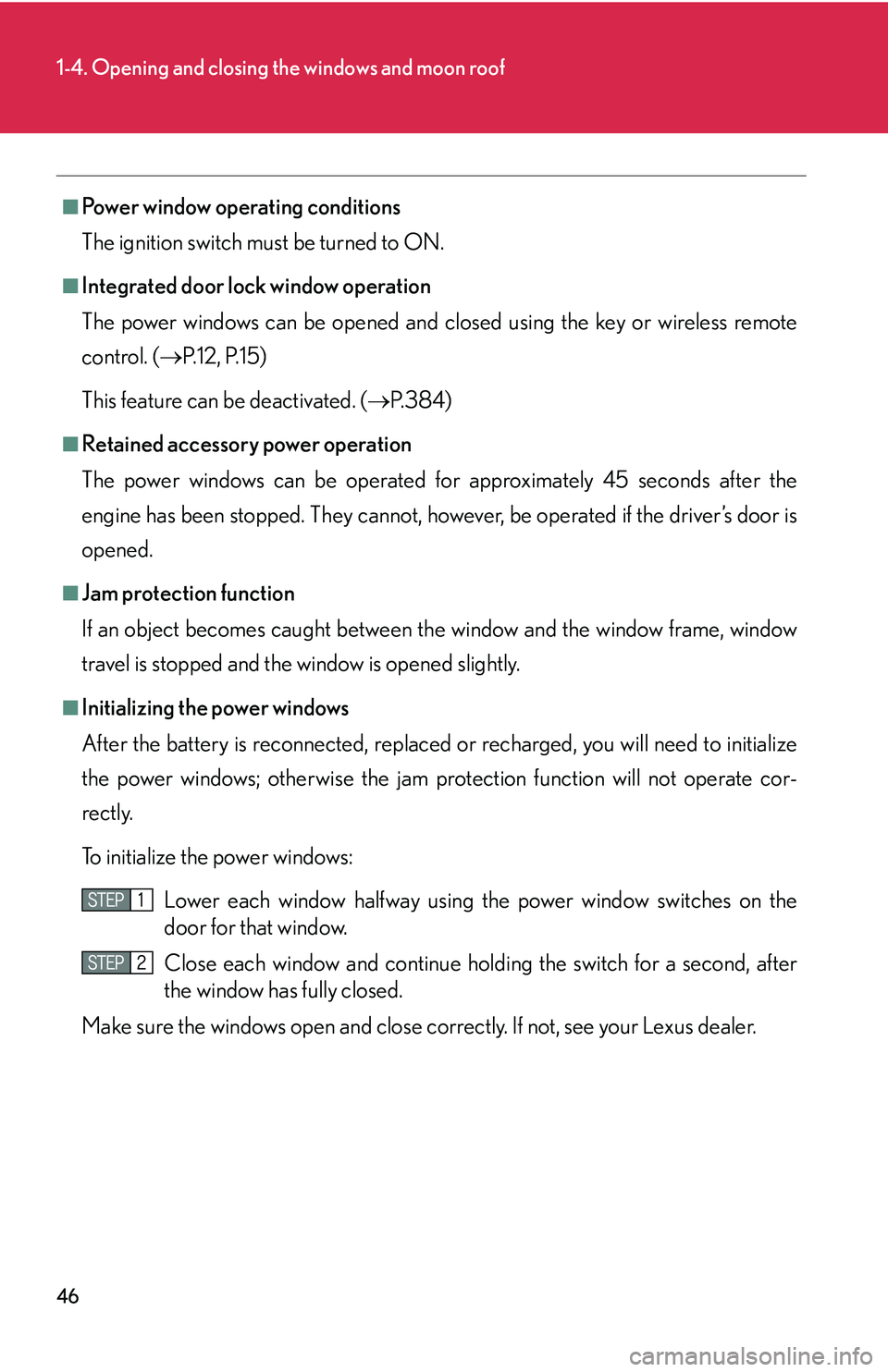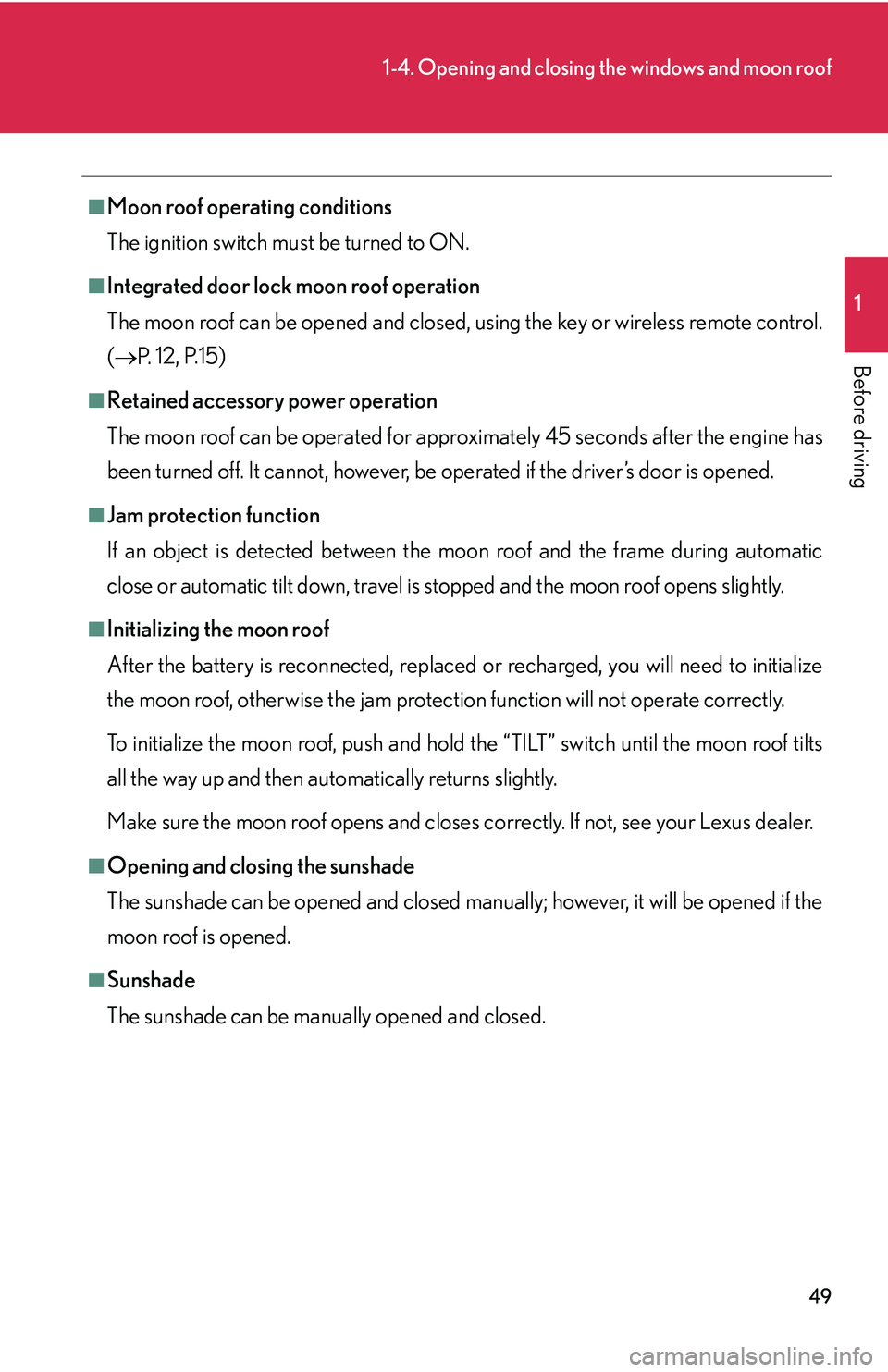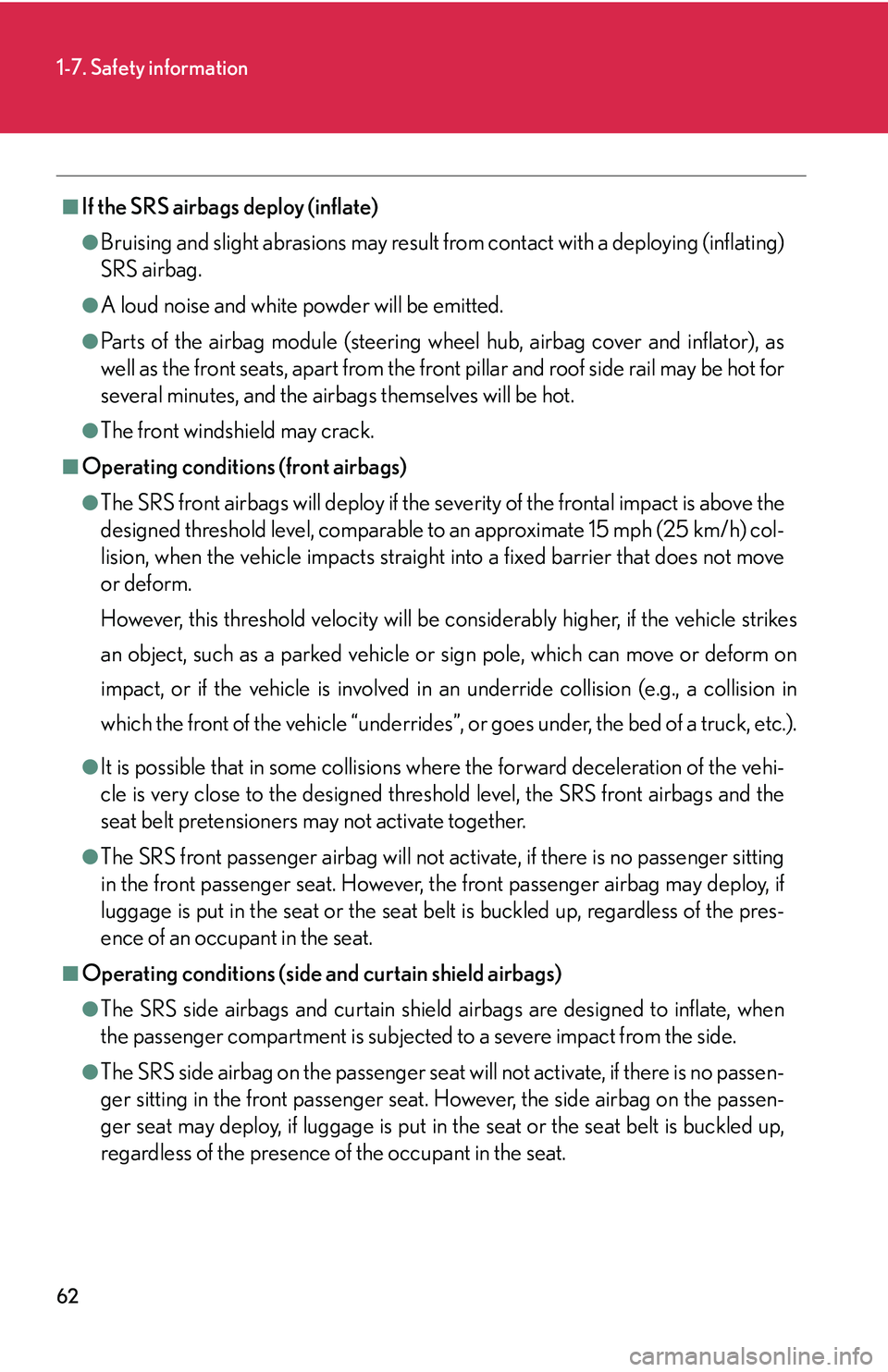Page 60 of 419

44
1-3. Adjustable components
■Side mirror operating conditions
The ignition switch must b
e turned to ACC or ON.
■When the mirrors are fogged up
Turn on the mirror heaters to defog the mirrors. ( P.
1 7 0 )
■Ignition switch integrated automatic operation
If the AUTO indicator light is on, the mirrors are in automatic operation mode.
• If the ignition switch is in the ACC or ON position, the rear view mirrors are
automatically extended and folded, if the ignition switch is turned to the
OFF position.
CAUTION
■When driving the vehicle
Observe the following precautions while driving.
Failing to do so may result in losing control of the vehicle and cause an accident,
r
esulting in serious injury or even death.
• Do not adjust the mirror while driving.
• Do not drive with the mirrors folded backward.
• Both the driver and passenger side rear view mirrors must be extended and pr
operly adjusted before driving.
■When the mirror heaters are operating
Do not touch the mirror surface, as the mirror surface becomes hot.
NOTICE
■If the mirror gets icy
Do not scrape the mirror face. Use a spray de-icer to de-ice the mirror.
Page 62 of 419

46
1-4. Opening and closing the windows and moon roof
■Power window operating conditions
The ignition switch must b
e turned to ON.
■Integrated door lock window operation
The power windows can be opened and closed using the key or wireless remote
co
ntrol. ( P.12 , P. 15)
This feature can be deactivated. ( P.
3 8 4 )
■Retained accessory power operation
The power windows can be operated for approximately 45 seconds after the
engine ha
s been stopped. They cannot, however, be operated if the driver’s door is
opened.
■Jam protection function
If an object becomes caught between th e
window and the window frame, window
travel is stopped and the window is opened slightly.
■Initializing the power windows
After the battery is reconnected, replaced or recharged, you will need to initialize
the po
wer windows; otherwise the jam prot ection function will not operate cor-
rectly.
To initialize the power windows:
Lower each window halfway using the power window switches on the
door for that window.
Close each window and continue hold ing the
switch for a second, after
the window has fully closed.
Make sure the windows open and close correctly. If not, see your Lexus dealer.
Page 64 of 419
48
1-4. Opening and closing the windows and moon roof
Moon roof
Use the overhead switches to open, close and tilt the moon roof up and down.
■Opening and closing
Open
The moon roof stops slightly before
the fully opened position.
Push the switch again to fully open.
Close
Push the switch in the opposite
direction to stop window travel
partway.
■Tilt up and down
Ti l t u p
Tilt down
Push the switch in the opposite
direction to stop window travel
partway.
1
2
1
2
Page 65 of 419

49
1-4. Opening and closing the windows and moon roof
1
Before driving
■Moon roof operating conditions
The ignition switch must b
e turned to ON.
■Integrated door lock moon roof operation
The moon roof can be opened and closed, using the key or wireless remote control.
( P.
12 , P. 15)
■Retained accessory power operation
The moon roof can be operated for approximately 45 seconds after the engine has
b
een turned off. It cannot, however, be operated if the driver’s door is opened.
■Jam protection function
If an object is detected between the m oon
roof and the frame during automatic
close or automatic tilt down, travel is stopped and the moon roof opens slightly.
■Initializing the moon roof
After the battery is reconnected, replaced or recharged, you will need to initialize
the moon r
oof, otherwise the jam protecti on function will not operate correctly.
To initialize the moon roof, push and hold the “TILT” switch until the moon roof tilts
al
l the way up and then automatically returns slightly.
Make sure the moon roof opens and closes correctly. If not, see your Lexus dealer.
■Opening and closing the sunshade
The sunshade can be opened and closed manually; however, it will be opened if the
m
oon roof is opened.
■Sunshade
The sunshade can be manually opened and closed.
Page 70 of 419
54
1-6. Theft deterrent system
Engine immobilizer system
■Conditions that may cause the system to malfunction
●If the grip portion of the key is in contact with a metallic object.
●If the key is in close proximity to or touching a key to the security system (key
with a built-in transponder chip) of another vehicle.
NOTICE
■To prevent damage to the key
The key may be damaged if it is:
•Bent
• Subjected to a strong impact
• Left in direct sunlight
•Wet
• Left in close proximity to objects emitting magnetic fields
• In close proximity to an object that inter
feres with the electromagnetic wave
that is emitted
Keep all keys in a safe place.
The vehicle’s keys have built-in transponder chips that prevent the engine
from starting, if the key has not been previously registered in the vehicle’s on-
board computer.
The indicator light flashes to indi -
cate that the system is operating,
af
ter the ignition switch has been
turned to the Lock position.
Ty p e A
Ty p e B
Page 71 of 419
55
1
1-6. Theft deterrent system
Before driving
Alarm
Deactivating or stopping the alarm
Do one of the following:
• Unlock a door using a key, r
emote entry or smart access
system.
• Turn the ignition switch ON.
The system will return to standby
mode approximately 30 seconds
after it operates.
The system is designed to trigger the alarm, if forcible entry is detected (horn
sounds and emergency flashers flash).
After exiting the vehicle, shut the
doors, trunk and hood, and lock all
the doors.
The system will begin operating
automatically af
ter 30 seconds.
The security system indicator light
will begin flashing when the system
is set.
Page 77 of 419
61
1-7. Safety information
1
Before driving
Airbag system components
The main SRS airbag system components are shown above. The SRS air-
bag system is controlled by the airb ag sensor as
sembly. The airbag sen-
sor assembly consists of a safing sensor and airbag sensor.
In certain types of severe frontal or side impacts, the SRS airbag s
ystem
triggers the airbag inflators. A chemica l reaction in the inflators quickly
fills the airbags with non-toxic gas to help restrain the motion of the occu -
pants. Front airbag sensors
Front passenger’s seat belt
buckle switch
Occupant detection sensor
Side and curtain shield airbag
sensors
Knee airbags
Front passenger airbag
Side airbags
Curtain shield airbag sensors
Curtain shield airbags
Driver airbag
Driver’s seat position sensor
Driver’s seat belt buckle switch
SRS warning light
Airbag sensor assembly
1
2
3
4
5
6
7
8
9
10
11
12
13
14
Page 78 of 419

62
1-7. Safety information
■If the SRS airbags deploy (inflate)
●Bruising and slight abrasions may result from contact with a deploying (inflating)
SRS airbag.
●A loud noise and white powder will be emitted.
●Parts of the airbag module (steering whee l hub, airbag cover and inflator), as
well as the front seats, apart from the front pillar and roof side rail may be hot for
several minutes, and the airbags themselves will be hot.
●The front windshield may crack.
■Operating conditions (front airbags)
●The SRS front airbags will deploy if the severity of the frontal impact is above the
designed threshold level, comparable to an approximate 15 mph (25 km/h) col -
lision, when the vehicle imp acts
straight into a fixed barrier that does not move
or deform.
However, this threshold velocity will be considerably higher, if the vehicle strikes
a
n object, such as a parked vehicle or sign pole, which can move or deform on
impact, or if the vehicle is involved in an underride collision (e.g., a collision in
which the front of the vehicle “underrides”, or goes under, the bed of a truck, etc.).
●It is possible that in some collisions where the forward deceleration of the vehi -
cle is very close to the designed thresh ol
d level, the SRS front airbags and the
seat belt pretensioners ma y not activate together.
●The SRS front passenger airbag will not activate, if there is no passenger sitting
in the front passenger seat. However, th e front passenger airbag may deploy, if
luggage is put in the seat or the seat belt is buckled up, regardless of the pres -
ence of an occupant in the seat.
■Operating conditions (side and curtain shield airbags)
●The SRS side airbags and curtain shield airbags are designed to inflate, when
the passenger compartment is subjected to a severe impact from the side.
●The SRS side airbag on the passenger seat will not activate, if there is no passen -
ger sitting in the front passenger seat. Ho
wever, the side airbag on the passen-
ger seat may deploy, if luggage is put in the seat or the seat belt is buckled up,
r
egardless of the presence of the occupant in the seat.